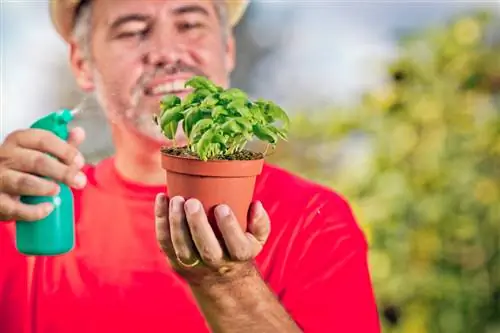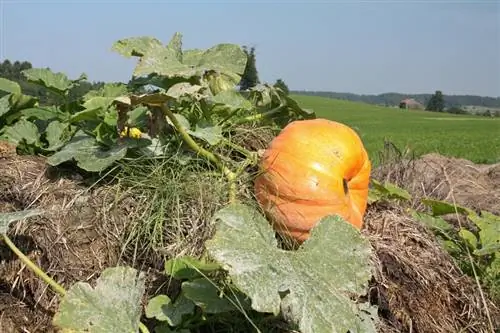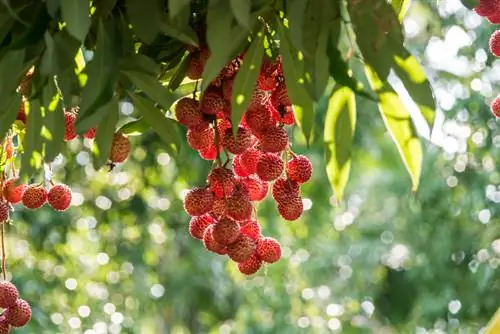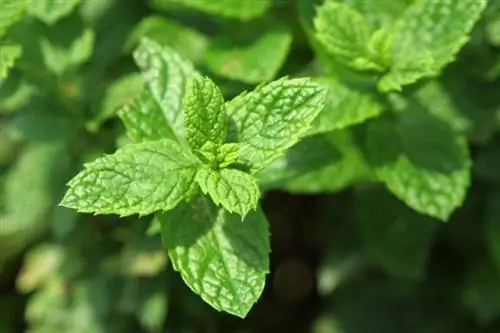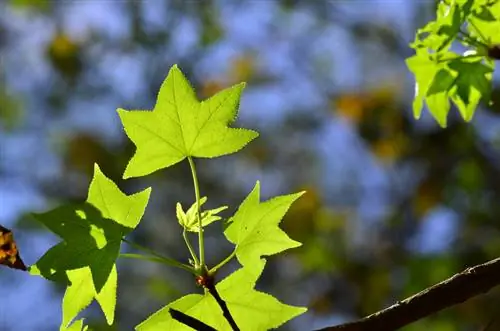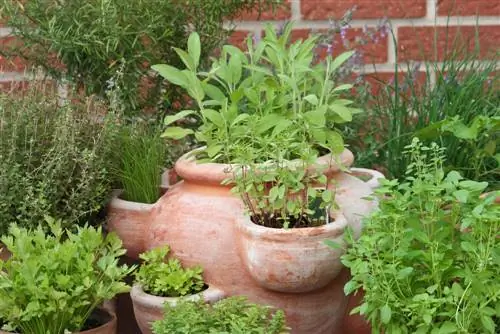- Author admin [email protected].
- Public 2023-12-25 17:45.
- Last modified 2025-06-01 06:02.
Stop worrying about the proper care of basil. Here you will find all the important answers to successfully cultivating royal herb in the garden and on the balcony.

How do I care for basil properly?
Proper basil care includes balanced watering, regular fertilization, pruning, overwintering and protection from diseases and pests. Make sure the substrate is rich in nutrients, in a warm location and avoid waterlogging.
How should basil be watered correctly?
A balanced water balance is one of the main pillars in the care of basil. The herb plant cannot cope with drought any more than it can withstand waterlogging. Check the moisture content daily using a thumb test and water immediately onto the root area if the substrate surface has dried. Ideally, place royal herb in a pot in 5 centimeters of water for a few minutes to water the plant from below.
To what extent should basil be fertilized?
In terms of nutrient requirements, basil is out of line because the herb plant is one of the heavy feeders. This fact already affects the choice of soil in the bed and pot. Instead of lean herbal soil, royal herb requires nutrient-rich, humus-rich substrate. Fertilization takes place in the following rhythm:
- fertilize in the bed every week from May to September with compost and horn shavings
- Work 100 grams of granulated cattle dung per square meter into the soil every 14 days
- Care for basil in the pot with organic liquid fertilizer
- Use guano fertilizer sticks in May and July with long-term effects
If you plant basil in pre-fertilized soil, give the first dose of fertilizer after 4-6 weeks.
Does royal herb need pruning?
Basil is cut for several reasons. Primarily for harvesting the aromatic leaves. In addition, to attract lush branching. Last but not least, regular pruning prevents flowering, which causes a bitter taste and heralds the end of the plant. How to cut royal herb correctly:
- Prince the plant from an early age to promote bushy growth
- for harvesting, always cut whole shoots with a length of 5-7 centimeters
- Cut back branches with buds forming up to the next leaf axil
As long as at least one pair of eyes remains on the plant, the basil will sprout again.
Can overwintering be successful?
Heat-loving basil stops growing at temperatures below 10 degrees Celsius. Frost is deadly for the tropical plant. Nevertheless, a multi-year culture is within the realm of possibility, provided that overwintering takes place in the protected environment of the house. First and foremost, the robust African varieties are up to this challenge. How to care for kingweed in winter:
- if temperatures fall below 12 degrees Celsius, basil moves into the house or winter garden
- ideal is a sunny, warm location at 15 to 20 degrees Celsius
- keep the substrate constantly moist without causing waterlogging
- fertilize organically every four to six weeks
Although kingweed doesn't want to be sprayed over the leaves, the very dry heating air can cause problems for the plant. Therefore, place the pot in a saucer filled with pebbles and water. The evaporating moisture envelops the plant in a revitalizing mist.
Which diseases are threatening - how should they be treated?
Since basil is not native here, the plant is sensitive to neglect in care and is susceptible to various diseases. The most common damage symptoms include brown or spotted leaves. Check whether you are caring for the royal herb properly. A cold, dark location or wet substrate often trigger brown spots. One of these two diseases may be behind it:
Leaf spot diseaseThis fungal infection primarily affects weakened plants or is triggered by already infected seeds. Remove all affected plant parts and dispose of them in household waste. So far, the only known control agents are chemical broad-spectrum fungicides, whose use on food plants is not recommended. Care for the affected plant carefully. Unless she recovers, she should be discarded.
Alfalfa mosaic virusThis widespread virus causes leaf whitening and vein yellowing, which causes the entire foliage to die. The vectors are often aphids or weeds. To combat the lice effectively, you should consistently pull weeds from the day of planting.
What pests can we expect?
Basil is not spared from voracious snails. In addition, the omnipresent aphids haunt the herb plant, bringing with them the aforementioned alfalfa mosaic virus. If a large butterfly flutters around the kingweed at night, it is probably the dock owl. This butterfly prefers to lay its eggs on basil so that its caterpillars can feast on the leaves.
If the shoot tips appear stunted and sucked out, the meadow bug is up to mischief. At the best time for basil in May and June, she lays her eggs and the larvae suck out the plant sap.
Tips & Tricks
Don't throw away coffee grounds. When dried, it works wonders on basil. Sprinkled around the plant from May to September, the ground coffee supplies it with important nitrogen. At the same time, the caffeine has a toxic effect on voracious snails.

